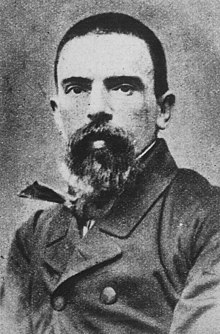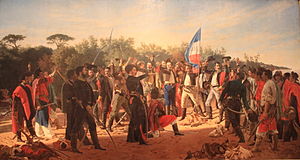Juan Manuel Blanes

You can help expand this article with text translated from the corresponding article in Spanish. (March 2022) Click [show] for important translation instructions.
|
Juan Manuel Blanes (June 8, 1830 – April 15, 1901) was a
Life and work
He married María Linari, and in 1855, the couple settled in
The experience became a valuable calling card for Blanes, who became one of Uruguay's most sought-after portraiteurs. The 1871 outbreak of a yellow fever epidemic in Buenos Aires inspired his first renowned work, which he exhibited to acclaim in the recovering city. His 1872 portrait of the Argentine War of Independence hero, General José de San Martín (The Review in Rancagua), was also a success in Buenos Aires, and Blanes was invited to Chile to display the historic depiction.[1]
Works of Uruguayan national importance

Returning to Uruguay, Blanes undertook a portrait of the "Thirty-three Easterners", members of a revolutionary vanguard whose insurrection against Brazilian authorities resulted in Uruguayan Independence, in 1828. The portrait's 1877 display was followed by Blanes' second stay in Florence, where he completed The Battle of Sarandí, a depiction of another milestone in Uruguay's nationhood. These works, and his bucolic portraits of life in his homeland did not garner the interest he expected in Italy, however, and the Blaneses returned to Montevideo in the early 1880s.[1]
Blanes resumed his portrait work, which remained popular among the local gentry. Among the most notable was a portrait of President Máximo Santos, commissioned by friends of the ruler as a gift. The most well known from this later period, however, was Artigas en la Ciudadela, an homage to one of Uruguay's most respected early patriots, José Gervasio Artigas.
Later life and legacy
This success was followed by the 1889 death of Blanes' wife, however, and he and his younger son, Nicanor, spent the next two years in Rome, where his elder son, Juan Luis, had settled.
He returned to Uruguay alone, and continued to create
The city of Montevideo established the
-
The Pure Susanna
-
The Paraguayan Woman (1879)
-
Artigas in Ciudadela (1884)
References
- ^ a b c d Museo Blanes: Biografía (in Spanish) Archived 2009-02-10 at the Wayback Machine



